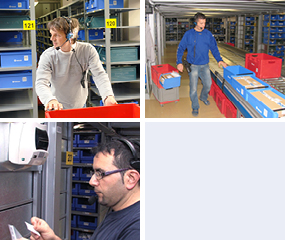
To expand the topic: voice-over-IP is a technology for communicating with a user. Via a headset (headphone and microphone), a voice synthesizer reads out commands to the user. Return information are received and processed by voice recognition. Thus, the worker has his hands free for handling goods or load carriers. The voice terminal is worn on the belt with a clip. This way, he will not only have an advantage in handling, but he will be also faster in processing as keying in, scanning, picking up and placing down the terminal is not necessary. At Riegler and AKF, the picking performance could be increased and the error rate and the training time for new employees could be reduced considerably this way. Not only different voices are recognized, but each user trains the system to understand him. Keywords and numbers are announced to the user and the user expresses them with his own “voice”. As universal the system might be, as individual it is.
Pick-by-voice is only one application. Storage via voice terminal is possible as well. As with order picking, the worker specifies the check digit of the storage location to finish the job. However, there a certain restrictions (the user, for example, cannot select another storage location than the one he predefined – entering a complete storage location code via voice would be too prone to errors), because the language scope should not become too large – more information will lead to more errors or wrong interpretations. Terminal processing is based on the functions that are also used by simple radio data transmission (handheld terminals, stacker crane terminals). It does not make any difference how a frontend acknowledges, but what it acknowledges in which quality. Considering the voice terminals as frontend in our layer model of warehouse management makes it possible!